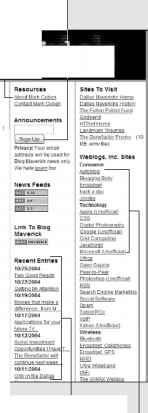Generating Buzz for Your Blog
The power of blogs is buzz, or conversations and Web links that bounce from blog to blog and gather mass and impact. Companies that use blogs as buzz-building tools are finding substantial readerships of people who avidly want to know what the blogger has to say and respond with comments to every new posting. The best part is that they often spread that message to others within their sphere of influence through blogs, instant messages, or e-mail.
Word of mouth is one of the strongest marketing tools your company can use. For example, a recommendation for a product or service from a trusted friend is more memorable and convincing than the cleverest television ad — and more likely to be turned into action.
What if you had a tool at your disposal that could reach hundreds of people at once who are actually interested in your products or services and appreciate the fact that you're making information available to them? A Weblog is such a tool. Blogs are all about opening up your knowledge, expertise, processes, and goals to your customers. Done right, they can give back loyalty, goodwill, and valuable feedback.
The blog format is breaking new ground for business by:
^ Providing a way to interact with customers ^ Being a clearinghouse of information and expertise
^ Getting valuable feedback — including criticism — from those who know your products and services best: customers
^ Changing public opinion during times of negative attention
^ Simplifying and amplifying collaboration between employees
The informal, engaging style and interactive format of blogs make them very attractive for companies looking to change public perception, take part in a dialogue begun in the press, correct a mistake, take a position, and get feedback from customers.
Best of all, blogs are a nearly instantaneous publishing format; the software that runs a blog speeds up, instead of slows down, the publication of news and information to your Web site. They're easy and cheap to set up; from a cost/benefit point of view, blogs are very easy to justify, and results come quickly.
Blogs are a great way to keep employees and customers abreast of the latest news faster and more effectively than a traditional company newsletter. They disseminate announcements more quickly than the most centrally placed bulletin board. And they can get you customer feedback more cheaply than any focus group or survey.
But what makes a blog different from any other corporate Web site? A blog is designed around a particular form of publishing: frequent, short updates often using links, accompanied by a corresponding set of comments from readers. Blogs are an organic process, meant to be written and read regularly — even daily — and simply aren't as "packaged" and controlled as a press release. Their tone is usually informal, almost stream of consciousness. In fact, many bloggers don't bother to use capital letters or spell-checkers!
A typical business blog
A good blog format contains a combination of these elements:
I Name: You almost always find the name of the blog at the top. It is usually short, catchy, and humorous.
I The latest post: The date, and occasionally the time, display so that you know which entry is the latest one. Unlike the front page of most business Web sites, a blog home page is usually quite long, because older entries also display on the home page.
I Comment link: After each entry, most bloggers invite the reader to add a comment.
I A collection of related info: On the right- or left-hand side of the browser window, this info may consist of e-mail subscription opportunities, explanatory or biographical information, archived entries, and links to other blogs that the blogger reads regularly and recommends.
The following figure is a good example of a standard blog format and layout. Blog Maverick
(www.blogmaverick.com) is the blog of Dallas Mavericks owner Mark Cuban.
Latest post
Blog name or logo
E-mail signup opportunity
Latest date and time bio
About explanatory link
Log mavericK
the mark cuba 3 woblog
Two Good Reads
-Posted Oct 25.2004, 5:34 PM ET L-|- people always ask me tor reading suggestions, so hare are 2 vary simpia ones
The first is one of Hie best stc-orr arket columns as'allssie. This guy doesr get the credit l .s deseives but in my opinion his column is a must read nama is Chris Byron, ami ha wiles about stocks ana the markats lor The NY Post
Chns unlike man* has no problems taking cn issuesItiatsren't popular out that pialcd the iridr/iduul investor His column liiduv should be tequiied read iglor anysmsJi irwestortninrjng oNrr/esira in penny stocks. He nails Ihe problems with Reg D offerings, gives examples and most importantly follows up to comrn just he* slimety some companies are if at are using this instrument
Switching fopics to career acMce.The book is called * Golra corooraae: Mtwirti un without Screwing Un ' If ]fou sre jiisl galling out of sdiijol and already in the corporate world this book probably isnfforyou. You a:ready know what's in il.
Forlhose new or about to be college arads who want a funny, lauah cut loud catch up 0<1 It" ?. things your Mure co-workars .Mil bp drnng "nr jpy, with you and to >ou Wen you slart your new Job, buy this be ok r ow. it His bookrsnljuslior new emnes into the workforce. If yciu run a company manage one, oi aie It'll! CEO of any company with cubicles or rows oi desk any*tiere you pay rent this book is de*nlteiy lor you. Vou have no idea what is happening not to and an all Ihose computers Humming away in the ottice. This two* will gr#e you the rundown on all Ihe Ihinos you never had Ihe guts to do when you started out In Sie business world. Read this book as a primer, and a good laugh on just what runs vuûuçh Ihe minds c* these îA'enîr somelhlngs It at ca : vou alrlo your faca, and something compiateiy dtfaranl behind your back Goc-d things of course :J.
Read 'am and havB lunF Related Links t- L" I n I ; ; hü I : il d P;i'jv ; ; c; i n : I
* ^PTf^r^r- ik + -n; "n- * H. mmmflQlB m
Comment link

Archived entries Links to other Web sites and blogs
Although the writing may be free-form, a blog has some common organizational structures that make understanding and participating in the conversation easy for readers.
Continue reading here: Buzz Marketing with Blogs for Dummies
Was this article helpful?
